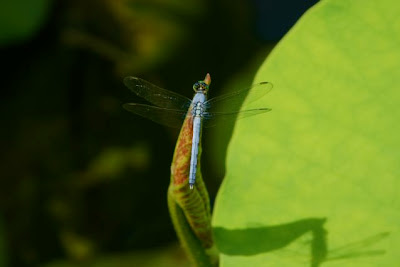At the Philadelphia Museum of Art, where we're working on color, perception, metaphor, and the evocative shimmers of remembered gardens as part of the
VAST Institute workshops, we were, on Monday, speaking of the senses writers tend to ignore. Smell and taste, perhaps because telling metaphors are elusive. Sound, because what we notice first—bird songs, insect buzz—seems somehow overly heard.
Today, while searching for illustrative examples to share by writers who are in possession of all their senses, not to mention all their wonder, I came upon this passage in Stanley Kunitz's
The Wild Braid. Scale is not a sense, of course, nor is the passing of time. But they are elements of framing and reporting that writers must finally master. With the simplest possible language, Kunitz takes back in time. He isn't trying to be a poet here. He's saying, This is how it was; this is how I moved through things and saw.
During my adolescence, out in the open fields, I would sometimes pretend I was one of the insects. I became captivated by dragonflies and imagined I could see the world as they did. Everything had a different scale.
I reveled in the sensation of being so light and being able to go anywhere, unburdened by a body.
Discovering the body was part of the joy, the sense of infinite possibility of being out in the woods. I recognized that it had weight and had certain limitations—there was no denying that. Obviously one's sensitivity was less acute than that of any other living creature in the woods. At the same time, the body was the very instrument of exploration.
I would find a leaf or a stone in the underbrush and have the sensation that nobody else had seen quite the same thing. And if I came across an arrowhead, that was a real triumph.
Sometimes, especially when one gets older, one gets very clumsy in the handling of delicate objects. The hands, the fingers, are less nimble than they were. But then, there's the compensation that one knows a bit more. There's a quid pro quo.
In the woods, one loses the sense of time. It's quite a different experience from walking in the streets. The streets are human creations. In the woods what one finds are cosmic creations.
 I was deeply saddened yesterday to learn, through my agent and friend Amy Rennert, that Carol Houck Smith, the long-time editor at W.W. Norton, had passed away. I met her only once, in 1998, when she escorted Gerald Stern to the National Book Awards, and sat with me and chatted, as if we were lifelong friends. As if I deserved to be there. I emailed with her just occasionally.
I was deeply saddened yesterday to learn, through my agent and friend Amy Rennert, that Carol Houck Smith, the long-time editor at W.W. Norton, had passed away. I met her only once, in 1998, when she escorted Gerald Stern to the National Book Awards, and sat with me and chatted, as if we were lifelong friends. As if I deserved to be there. I emailed with her just occasionally.
But you didn't have to be in her physical presence to feel her emanating goodness, to know that the world was a better place because she lived within it. She edited Andrea Barrett, Rita Dove, Stanley Kunitz, Ron Carlson, Rick Bass, Joan Silber. She was, wrote Andrea Barrett in a statement printed by the Washington Post, the sort of editor who did "the simplest (and hardest) task: she asked questions. Questions that presumed the characters created on the page were actual persons, the actions real and consequential, the meanings a matter of life and death." She was the sort who made you feel welcome at her table, who wrote, once, to say that she had "just finished The House of Mirth, if you can believe that. I needed a respite from this century."
Of the books that she edited, I hold as most special The Wild Braid, that magnificent end-of-life collage by Stanley Kunitz. It was so perfectly odd, so uncontained, a spill of garden, words, living, conversation, photographs, and a nearly final page that seems just rightly quotable, this day, in which so many of us are fondly remembering Carol Houck Smith:
When you look back on a lifetime and think of what has been given to the world by your presence, your fugitive presence, inevitably you think of your art, whatever it may be, as the gift you have made to the world in acknowledgment of the gift you have been given, which is the life itself. And I think the world tends to forget that this is the ultimate significance of the body of work each artist produces. That work is not an expression of the desire for praise or recognition, or prizes, but the deepest manifestation of your gratitude for the gift of life.





Love Stanley K. And this. Thanks. My friend Anne - whom you shall meet, spent 6 hours in the woods the other day. She, too, revels in nature.